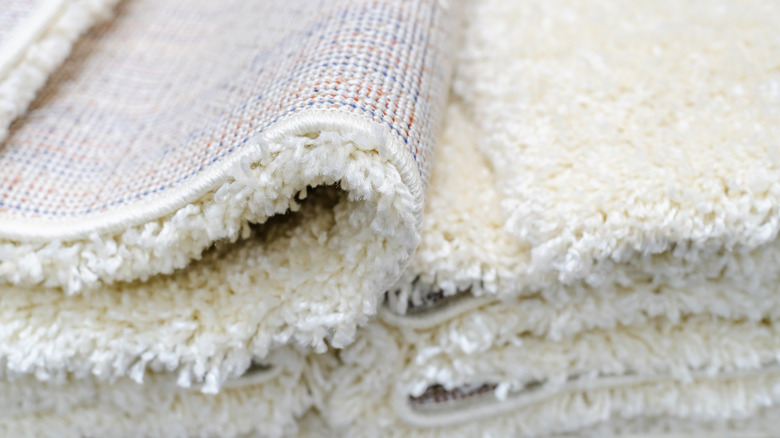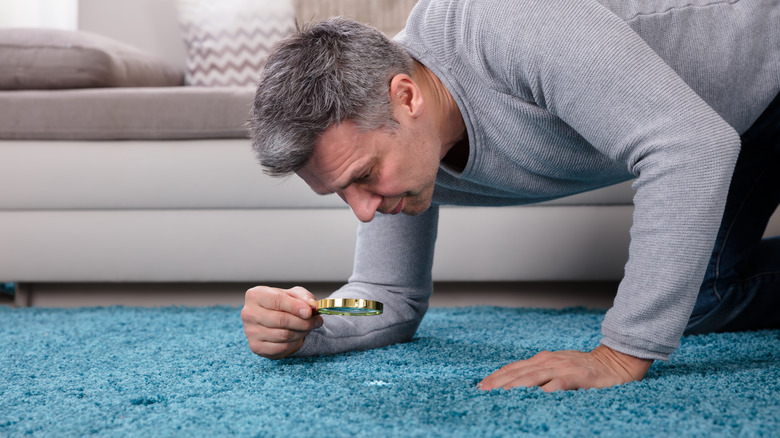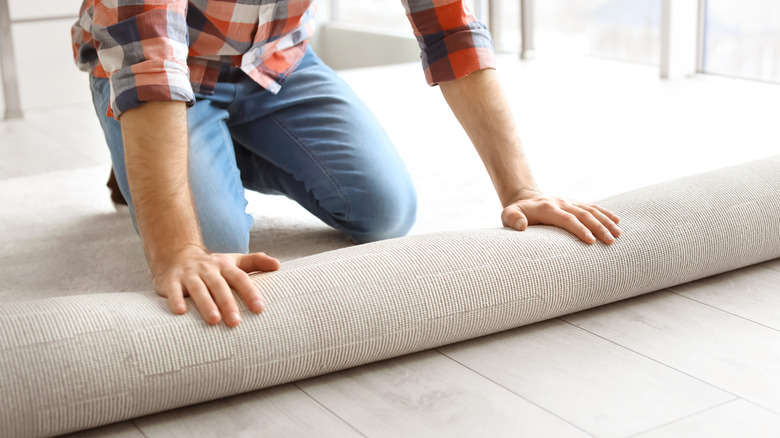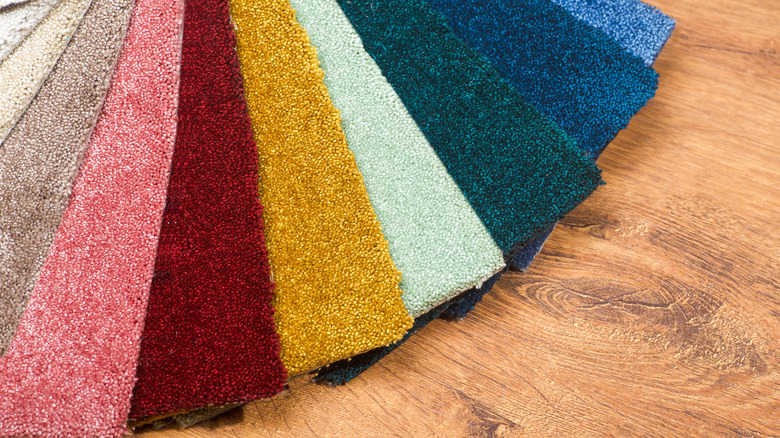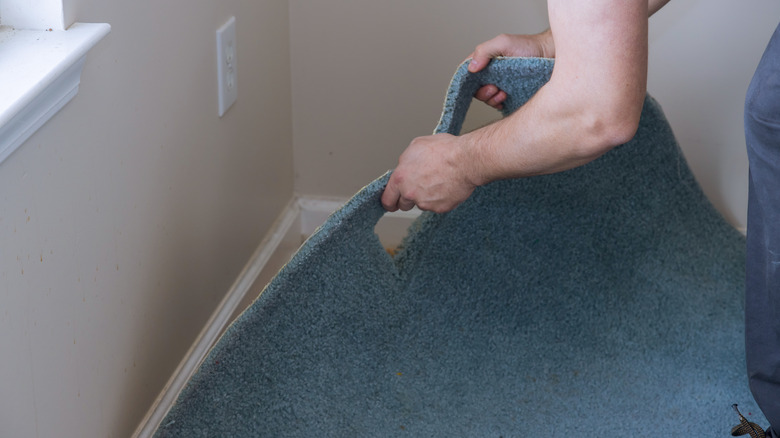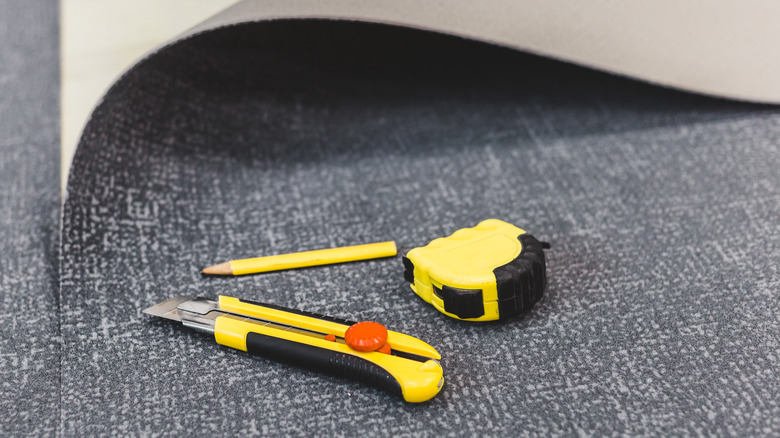How Much Does It Cost To Install Carpeting In Your Home
Carpeting provides a durable and uniquely comfortable solution that supports everything you do in the home. But homeowners often need to start thinking about replacement before their flooring reaches a decade of service (via The Seattle Times). Routine wear damages carpets over time, and the addition of spills and other accidents that mark the course of typical life can severely impact your home's ambiance as odors, stains, and general discoloration appear, potentially minimizing this timeline even more.
Replacement is inevitable but finding a great price on whole installation can be challenging considering the wide variance in price and the wealth of carpeting options available. According to a Forbes Advisor survey, carpeting rings up at $700 to $2,000 total for a roughly 200-square-foot target area, averaging out around $2.50 plus an additional $0.60 per square foot to account for the padding that lives beneath the luxurious upper layer you've chosen.
Additionally, depending on the type of carpeting you decide to install in your property, this price tag can balloon or shrink with the material, quality, and style selected. Ranging between just $0.65 and up to $12 per square foot, the choice can quickly become a bit more complicated. Selecting from the favorites — wool or polyester — will give you a broad range of color options and foot feel to match any need you may have.
Factors for cost
Many factors play a role in the cost of carpet installation. The Forbes Advisor team, while elaborating on typical pricing and experiences in this task of homeownership, notes in their reporting that labor shortages, material demands, and other elements in play as a result of the COVID-19 pandemic can impact local fluctuations from this average price point in unforeseen ways. This makes planning and comparing key resources for anyone considering a carpet replacement. Comparison shopping is always worthwhile, regardless of the consumer good in question, but in the flooring market price differences amongst suppliers and additional considerations stemming from a still-recovering economy can mean the difference of hundreds of dollars simply by taking the time to broaden your search.
Of course, the material you select will play a major role in the overall price and this acts as the primary driver of cost. Wool and polyester are perennial favorites, but nylon, olefin, acrylic, and others can offer a great alternative for specialized needs or a buyer on a strict budget.
Wool
Natural fibers like wool offer a great standard of luxury in the home, and wool in particular is often claimed to be the "best" carpeting material. But homeowners will often opt for synthetic fiber carpets like polyester for a cheaper overall expense and an easier cleaning and care regimen. Wool is the most expensive base material you'll find in this list (averaging $7.50 per square foot), but the price tag comes along with some unique benefits that aren't matched in other materials. Wool is a natural fiber (sheered from sheep) and will feel the softest on your feet as you walk throughout your home.
But wool can suffer from color fading and easily absorbs water, making it more difficult to care for than synthetic alternatives and allowing for less control over mildew and the presence of unpleasant smells that result. The tradeoffs of bringing in a luxury flooring material are something that you'll have to decide on for yourself.
Acrylic and Polyester
Acrylic is a great alternative to wool, and the material's ISO rating (International Organization for Standardization) means that each textile made from acrylic will, by definition resemble the softness of wool more closely than virtually any other fabricated thread. It's for this reason that many manufacturers offer a range of acrylic carpeting options. They may even provide a blend that incorporates wool into the equation for an even softer feel that takes advantage of the stain and water resisting features that are a staple of synthetics. A pure acrylic will cost around $5 per square foot.
Polyester is another great option in the synthetic category. The fibers are naturally resistant to problems relating to moisture retention. What's more, blended rugs that incorporate wool are common in this category, too. Polyester imitates the look of natural wool, but it's far more stain-resistant. A polyester-only option is among the cheapest of the bunch, coming in at around $2 per square foot.
Nylon
Nylon carpeting is a property investor's best friend. Nylon typically costs around $3.50 per square foot and enjoys natural tensile strength and stretch. This means that it's highly durable and will resist divots and heavy wear from the movement of furniture and feet around some of the highest traffic areas in the home. A high quality nylon carpet can last for many years in a home that will see a revolving door of tenant agreements and different furnishing arrangements.
Olefin
This last entrant is typically one of the least expensive options (around $2 per square foot), and it provides homeowners with a durable flooring option that is stain and water resistant. Olefin carpeting has a tendency to attract oil and suffers from matting, so may serve the home best in utility rooms, closets, or other areas that would benefit from carpeting rather than a bare floor but won't see much footfall.
Additional costs
It's important to consider additional costs when making any alterations to your home. Carpeting is no different in this regard.
Installation costs can vary
In many instances you can expect a free installation when purchasing carpet from a retailer, but these costs will end up bundled into the overall price for materials, per Forbes Advisor. However, this isn't always the case. In the event that installation is separated out, you can expect to see a price tag ranging from about a dollar up to $6 per square foot. Speaking with a supplier will help you understand your unique costs that go beyond simple square footage pricing for the materials alone. Likewise, it's a good idea to form an understanding of the price difference when adding or subtracting the actual installation work directly from the supplier you're thinking of using.
Under carpet padding is a crucial addition
One addition that overwhelmingly makes its way into the total price of a new carpet is the underlayer of padding. Installing padding beneath the carpet is a necessary step in any application that is built to last. This layer will make for a more comfortable experience and help maintain heat retention and the overall health of your carpet for the long haul.
Preparation time and work may increase the cost
As well, a poorly maintained home may require additional cleanup and prep work before a new carpet can be laid at all. It's important to ensure that your base subfloor layer is completely clear of debris and grime before laying down a new padding and carpet since these are likely to remain in place for another 10 years (covering over a clean layer or one that's caked in grit and gunk), advises Home Depot. In any home, if additional cleaning is required before starting on the new installation, it will be worth the time and expense to ensure the job is done right.
VOCs are an additional consideration
It's also important to note that many padding and carpeting options can include volatile organic compounds (VOCs) that may affect your lifestyle and comfort — and in extreme cases of chemical presences can constitute a health hazard (via the CDC). VOCs are often found in varying degrees within synthetic materials, and typically manifest in the form of a noticeable smell in the case of new carpets. Manufacturers across the country offer a range of products that are low in VOCs or have eliminated them altogether, but these designations are often factored into the cost as a premium.
Types of carpeting options
Carpeting is created with familiar, standard materials, but construction methods also play a role in the feel you'll experience at home, as well as the durability and quality of the update itself. According to The Spruce, regardless of the texture or pile selection you make, the most important part of installation lies in pile direction — or the direction that each fiber naturally faces within the sheet of carpeting. Laying carpet inline across a space will provide for increased durability, but it also helps to ensure that the room enjoys a seamless feel rather than a disjointed one.
Pile direction plays a role in the amount of carpet you may need to purchase, too. Square rooms will be easy to measure, but when it comes to matching hallways, the smart purchase is likely one that overorders so that your carpet's pile will run in the same direction across all connected areas of the home. Once you've identified the volume of carpeting that's required for your project, the next step is to select the pile type that best suits your style and needs.
Textured or Cut Pile Carpeting
Textured carpeting (also known as cut pile) is overwhelmingly the most common option in the residential market. This is the iconic choice and can be found in either high or low pile (fiber length). The pile is simply the fabric loop that is run through the bottom of the material and stands up to provide a soft, smooth surface. This type of carpeting involves a cut across the texture to ensure an even height and uniform bristles that standalone and are easier to care for than other conventional options. These types of textures will typically run you $2 to $4 per square foot.
Loop
Loop carpeting is a more durable option but isn't appropriate for homes that include pets. As suggested, a loop carpet pile is one that hasn't been cut flat after being constructed and the fabric extrudes from the underside sheath in actual loops rather than individual strands. These can easily snag on a dog or cat's nails and pull lose. In serious instances this can also cause harm to the animal. Loop pile is incredibly durable, though, and won't leave vacuum or walking track marks. A loop carpet ranges between $2.78 and $5 per square foot (via Bob Vila).
Berber
Berber patterns are taken from a traditional construction originating in the Berber region, a stretch along the Northwest African coast and drifting southward into the continent. These carpets are marked by a knotty, looping format that holds up better over time than cut options. These typically average out to $5.50 per square foot.
Patterned
This carpet variety is often seen in the form of welcome mats and other small rugs; however, the texture fits right at home in larger carpeting varieties, too. Patterns used in these types of carpets often make use of blended fiber materials and can provide a wealth of unique style and functionality additions to a property. With the variance among patterned carpet options, it's no surprise that the cost fits in a somewhat wider range as well (from $2 to $6 per square foot).
Why you need a new carpet
Carpeting gets old and loses its inherent qualities of comfort, style, and luxury over the years. One thing that many homeowners find in an aging carpet is a distinct and unflattering odor. As reported by Angi (formerly Angie's List) amongst four of the primary culprits are smoke, food or pet related accidents, and moisture. But age can bring in an unpleasant smell all on its own. As you continue to walk across the carpet and live in the space the fibers will naturally soak in all the elements they've been exposed to over many years.
Old carpets are a burden when it comes to a sale
Aging carpet is a detriment to a homeowner's mobility during a sale opportunity. The National Association of Realtors reports that average U.S. homeownership hovers around 13 years in a given property, with data skewing even shorter in communities dubbed as "metro areas" across the country. A new carpet can be a great investment for a homeowner thinking of moving on in the coming months because aging flooring acts as a powerful turnoff for many buyers.
Consider the DIY route
It's also an interesting option to consider installing carpet yourself. Many people have taken to the world of Do-It-Yourself, and if you're a real estate investor this approach can be a great way to save on the overall cost. By installing new flooring yourself, you can shop around for the best price on the market and even use an e-Commerce retailer rather than a local outlet if a bargain can be found beyond your practical geographical range.
The DIY Route takes patience and care
Tearing out the existing carpet isn't a particularly specialized task, but it's important to leave the existing tack strips that perimeter the room, especially on concrete subflooring that's often found in basements and in ground floor spaces. Cleaning the surface and pinning down new padding takes accuracy and care, and a careful approach to the top layer of carpet is all it takes to finish off the job. After measuring the carpet, you'll want to start methodically tapping down the edges, making sure to always work toward corners rather than away from them while stretching the carpet across to maintain tension. It might be easiest to think of this process in the same way you'd move from one corner to its opposite while putting a new sheet on the bed.
While the sweat equity involved in a DIY installation is considerably higher, if you're confident in your ability to pull off the job it may just save you a few hundred dollars, according to Austin's Floor Store — certainly nothing to scoff at! However, approaching an installation yourself is a big task and shouldn't be underestimated. Each step in the process can be time-consuming and this approach will require specialized tools to ensure a proper fit. This is an important decision, and many homeowners do opt to hire a professional rather than take on the task themselves.
Benefits of a new carpet
The benefits of new carpeting are numerous, and they begin with your family's level of comfort at home. A new carpet is far superior to an aging flooring solution, no matter the material. The feel of a newly installed carpet in a room or the whole house can provide your space with a renewed energy.
Air quality and ambiance are affected by carpet health
Installing new flooring can also help improve the air quality in your home, as noted by The Spruce. Removing an old carpet that's suffering from water damage or mildew provides rejuvenation that flows through the entire room. New carpeting is a great way to improve the heat retention in a cold room as well. Good quality padding combined with a high pile carpet layer can provide great insulation that will make your living space far cozier and more inviting.
The financials of a new carpet win out
Lastly, the investment value that new carpeting adds can help you maintain a kind of first mover advantage in your local real estate market. If your property is market ready — rather than needing essential renovations to attract serious buyers — then you can list it immediately in the event of a change in market conditions that suddenly sends your property's value skyrocketing (as it did for Long Island properties in the short term when Amazon's HQ2 plans were announced, per Bloomberg News).
Carpets are a mainstay in the modern American home. Focusing your attention on replacing old carpeting is one of the most effective ways to immediately boost the value and comfort that you enjoy as a homeowner. Considering all the options before you and making the right pick for your family will give you many great years in the property.
